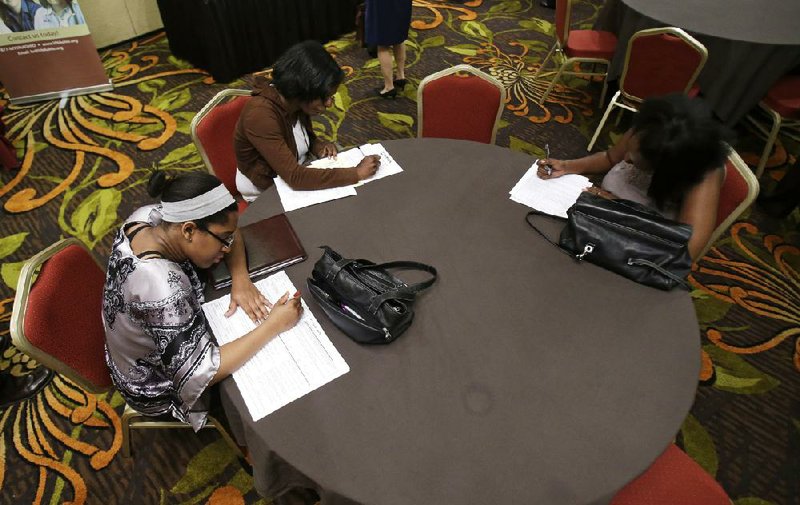Job openings rose in May to the highest level in almost seven years, a sign the U.S labor market will help economic growth in the second half of this year.
The number of positions waiting to be filled climbed by 171,000 to 4.64 million, the most since June 2007, the Labor Department said Tuesday. The number of unemployed job seekers per opening fell to the lowest level in six years.
Tuesday's data are among the labor measures monitored by Federal Reserve Chairman Janet Yellen and add to evidence that the job market is strengthening. Payrolls grew more than forecast in June, and the unemployment rate fell to an almost six-year low, figures showed last week.
Openings are "beginning to move in ways that inspire more confidence in the labor market," said Terry Sheehan, an economic analyst at Stone & McCarthy Research Associates in Princeton, N.J. "It's a pretty stable job market that's improving incrementally. It's good for the Fed."
The median forecast in a Bloomberg survey of economists projected 4.35 million openings in May.
The Job Openings and Labor Turnover Survey adds context to monthly payroll figures by measuring dynamics such as resignations, help-wanted ads and the pace of hiring. Although it lags the Labor Department's other jobs data by a month, Yellen follows the report as a measure of labor-market tightness and worker confidence.
In the past year, job openings have increased nearly 20 percent. But total hiring has risen just 4 percent.
Some economists say that is a sign that many of those out of work don't have the skills needed for the available jobs. Former construction workers or factory employees, for example, may not be able to fill new jobs in health care or other growing fields.
Others argue that companies will have to offer higher pay to attract the workers they need. That could raise overall wages, which have barely kept up with inflation since the recession ended five years ago.
There are other signs pay could rise soon. There are now 2.1 unemployed workers, on average, for every job opening. That is the ratio that typically exists in a healthy economy and indicates employers may have to try harder to fill jobs, perhaps by boosting pay. There were 1.8 job seekers per opening when the last recession began in December 2007.
"We think the result is going to be a pickup in wage growth," said Cooper Howes, U.S. economist at Barclays Capital.
Payrolls expanded by 288,000 workers in June after a 224,000 gain in May, Labor Department figures showed last week. The unemployment rate fell to an almost six-year low of 6.1 percent, from 6.3 percent.
In Tuesday's report, the number of people hired cooled to 4.72 million in May from 4.77 million, pushing down the hiring rate to 3.4 percent from 3.5 percent. The latest reading compares with an average hiring rate of 2.8 percent during the previous expansion. The gauge calculates the number of hires during the month divided by the number of employees who worked or received pay during that period.
Job openings increased at factories, construction companies and providers of business services and health care. The rate of openings climbed to 3.2 percent in May, the highest since August 2007, from 3.1 percent.
Separations eased to 4.5 million in May from 4.55 million.
Some 2.53 million people quit their jobs in May, up from the prior month's 2.47 million. The quits rate, which shows the willingness of workers to leave their jobs, held at 1.8 percent and is down from a 2.1 percent reading when the recession started at the end of 2007.
Total dismissals, which exclude retirements and those who left their job voluntarily, decreased to 1.58 million from 1.7 million a month before.
In the 12 months ended in May, the economy created a net 2.3 million jobs, representing 55.3 million hires and 53 million separations.
Gains in hiring will help generate the income growth needed to spur consumer spending, which accounts for almost 70 percent of the economy.
Businesses expanding employment include Ford Motor Co., where hiring is so strong that the automaker predicts it may beat a 2011 plan to bring on 12,000 new workers by 2015. Warren Buffett's BNSF Railway Co. plans to grow by 2,100 positions in 2014.
After a first-quarter contraction, gross domestic product probably bounced back in the second quarter and will expand at an average 3.1 percent rate in the remaining two quarters of 2014, according to the median forecast in a Bloomberg survey conducted in early June.
Information for this article was contributed by Shobhana Chandra of Bloomberg News and Christopher S. Rugaber of The Associated Press.
A Section on 07/09/2014

